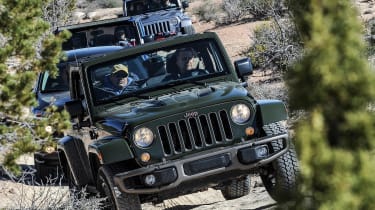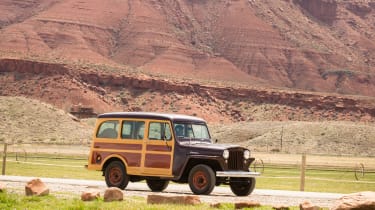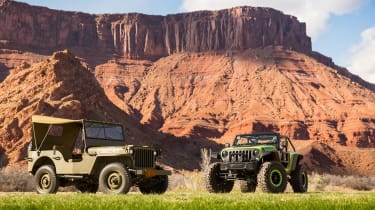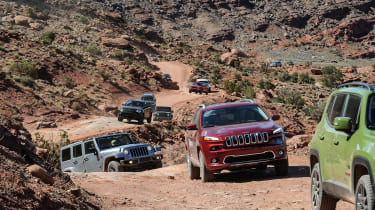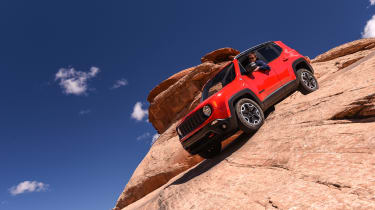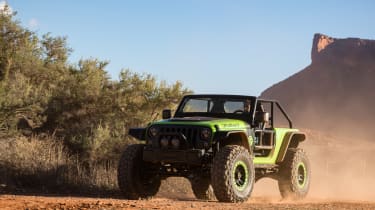75 years of Jeep - we drive America's most iconic 4x4s
We head to Utah to join Jeep's 75th birthday celebrations
Jeep. Four letters that for many people around the world represent everything American. Even on its home soil, Jeep has been named the most patriotic brand for the past three years – it’s unequivocally American, and its heritage is gilt-edged and a marketeer’s dream.
Britain has its own version, of course. But as much as Land Rover wouldn’t like to admit to it, Jeep is the preface to its own story. Like most prefaces, though, this is the bit that tends to get overlooked. Just like Land Rover, Jeep has had its own share of ups and downs. Moreover, just months after the British company’s last grandfather, the Defender, rolled off the production line, Jeep turns 75.
Jeep headed to Moab in Utah for its birthday celebrations. The famous red sand and jagged mountains have become Jeep country – it’s the place Jeep feels its image lies. And we got the chance to take part in the celebrations, explore the brand’s rich history and learn that the future is bright.
We drove Jeeps old and new on Utah’s rugged trails, from the original Willys MB to the modern Wrangler. And while the latter looks like the WWII Jeep, it couldn’t be any more different from behind the wheel. The controls are conventional, the steering assisted and easy to use, the ride far more comfortable and the engine doesn’t have the MB’s whine, which has graced many war movies. But the sense of adventure remains in the Wrangler and even the Renegade.
The MB’s characteristic quirks are nowhere to be found on 1984’s Grand Wagoneer, though. Nicknamed the Grand Daddy, this was a favourite among eighties celebrities. Its bodywork, plus its leather and wood trim, scream excess.
Yet Jeep’s real home isn’t Utah; it’s 1,700 miles west in Toledo, Ohio. This is where the story began with the Willys MB, and it’s been told many times. Willys-Overland, along with car company American Bantam, were the only two bidders to pitch for a US War Department contract to build a Light Reconnaissance Vehicle. Bantam’s design appealed to the War Department, but it felt the company was too small to build in the quantities the Army wanted, so it passed the design to Willys and Ford, and the Willys MB was born.
There’s some confusion over the origins of the ‘Jeep’ name – some say it’s the colloquial abbreviation for ‘GP’ or General Purpose, some that it’s linked to Ford’s version, called ‘GPW’, and others that it was a name coined by American GIs in reference to Eugene the Jeep, a character in Popeye cartoons. Wherever the name came from, by the end of WWII, Jeep was synonymous with the Allied victory and more than 380,000 MBs had been built.
As the war ended, the idea of a four-wheel-drive car seemed highly appealing to many manufacturers across the world – not least in Britain. Instead of mothballing the production lines, Willys-Overland decided to use the MB to head into uncharted waters and build a four-wheel-drive ‘Jeep’ for the masses, so it created the CJ-2A. Advertised as the ‘Civilian Jeep’ – hence ‘CJ’ – and ideal for farmers and construction workers, it was little more than an MB with a tailgate, a spare tyre and a better gearbox. It also had larger headlights, so two of the ‘slots’ in the grille had to be lost, creating the seven-slot design we know today.
Over the next few decades, Jeep created a range of SUVs, 4x4s and pick-ups. And it’s arguably the godfather of many of the SUV variants we have now. The 1946 Willys Wagon could claim to be the world’s first SUV. The steel-bodied station wagon has seven seats (six were removable), so it made a great estate or even a forward-thinking MPV.
Before 1949, adding four-wheel drive to a station wagon was unheard of – power to all four wheels was deemed too agricultural for civilian use, but Willys broke new ground by introducing a four-wheel-drive Wagon in 1949. It was just the start of opening up the world of 4x4s to the masses. The 1955 CJ-5 could be the first recreational 4x4, 1963’s Wagoneer the first premium large SUV and 1984’s Grand Wagoneer can argue with the Range Rover over the title of first luxury 4x4.
Despite all these hits, Britain was largely unaware of Jeep until the early nineties. Over here, Land Rover was the guardian of the off-roader, and until the Cherokee arrived in 1993, a Jeep was just a WWII vehicle. But the Cherokee quickly established a loyal following, with its lusty engines, plush cabins, keen prices and rugged ability. Soon after, the ancestral Wrangler appeared, as did the Grand Cherokee.
• Land Rover Defender Heritage review
Compared to these standout models, it’s no wonder Jeep’s future was in doubt at the start of this decade. Wounded by the credit crunch, the brand’s range was epitomised by the Patriot. It did Jeep no favours and the business was in trouble.
“We were this close to pulling out of the UK,” says the blunt-speaking Steve Zanlunghi, UK managing director and head of Jeep in Europe, the Middle East and Africa. “When we came out of bankruptcy, Jeep had got away from its roots. In 2012 when I came from the US, where the Jeep brand is iconic, to the UK, the home of Land Rover, our brand perception was below Suzuki and Mitsubishi.”
Zanlunghi was summoned to a crisis meeting with Fiat Chrysler Automobiles CEO Sergio Marchionne in Turin to explain Chrysler Jeep’s dire performance on these shores. He recalls: “I told him our dealers were losing money, we only had 40 per cent coverage in the UK and that meant a three-hour drive to a showroom – and you really have to want a Jeep to do that.” With FCA poised to axe the brand here, Zanlunghi revealed his plan to combine Alfa Romeo and Jeep showrooms to make them more prominent.
• 60 years of the Land Rover Defender
“He said go for it,” Zanlunghi continues. “We started on the plan and introduced Grand Cherokee, Cherokee and Renegade. Slowly but surely dealers are buying into it. We are at 90 per cent coverage and things are going well.”
Jeep’s turnaround in the UK is pretty remarkable, in fact, and this is largely down to the Renegade. “March 2016 was the best month in the UK for Jeep ever,” says the UK boss. “We sold over 2,500 cars, beating our previous best month of August 1997 – 2,500 cars is greater than the entire individual years of 2009, 2010, 2011, 2012 and 2013.
“Renegade started it and it has had a halo effect. We received criticism for making it the most capable compact SUV. It’s turned out 49 per cent of Renegade [buyers] in the UK go for the 4x4 versions, so our next car will be the same – true to our heritage and the most capable in its class.”
Zanlunghi has high hopes for the as-yet-unnamed Nissan Qashqai rival, due in 2017. Critics will say Jeep is late to the party, but he claims the sector is worth around 39 per cent of the market, and he wants his car to account for 39 per cent of his business and be a top 10 seller in its class.
Before then, the Grand Cherokee will be facelifted, while after the Qashqai rival launches, the Cherokee will be refreshed, an all-new Wrangler will come in 2018 and there will be a new range-topping Grand Wagoneer. A Wrangler-based pick-up will follow by the end of 2020. “We’re on the road to recovery,” says Zanlunghi, “but we’re not done yet.”
What else does the future hold for Jeep?
V8 Wrangler
A large group of Jeep fans has been gathering at Moab in Utah every Easter for years to tackle a series of off-road challenges. Recently, the brand has taken over the event to show off new cars.
This year, most of them showcased accessories and parts from the Mopar range, but there were also a few eyebrow-raising concepts. Jeep revealed new pick-ups based on the Renegade and Wrangler, with the latter – inspired by the old Gladiator – thought more likely to lead to a production model.
It also showed off the Wrangler Trailcat (below). This is as far removed from the Willys MB as possible, with 707bhp from a Dodge Challenger-sourced V8. It’s unlikely to make dealers, but shows how confident Jeep is.
Hybrid tech
While rivals such as Land Rover, Mercedes and Audi are racing to satisfy demand by producing hybrid and electric SUVs, Jeep isn’t in a rush to follow. It’s happy to watch and wait instead.
UK managing director Steve Zanlunghi tells us: “We don’t have customers demanding [we] produce hybrids and electric cars. If they ask us to, or the Government says we have to do this or we see a big demand in the SUV market for electric vehicles, we will embrace it. We can do it – we have the tech within the group – but we don’t see the demand.”
Under Fiat direction, Jeep is enjoying a big turnaround, not just with its product but with its attitude to building cars. “Until we merged with Fiat, we built cars for North America,” adds Zanlunghi. “We didn’t understand what CO2 was. In fact, I have a joke with our dealers we don’t measure our cars in grams of CO2 but kilograms!”
Wish Jeep a happy 75th birthday in the comments section below...
Find a car with the experts

